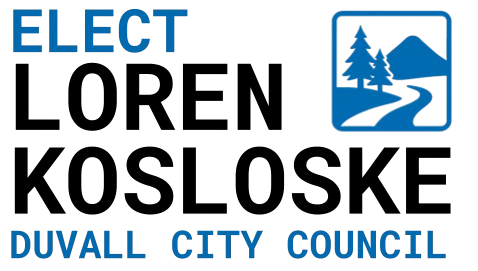City Growth & Expansion
Growth is coming. Let’s make it work for Duvall.
Over the last decade, Duvall has experienced a period of significant transformation. The vast majority of this growth has centered on residential development—new neighborhoods, subdivisions, and townhome communities have reshaped Duvall over the last decade. Toll Brothers, D.R. Horton, Duvall Village, and others have contributed to this rapid expansion. While growth has brought in new families and individuals, it has also raised serious and understandable questions: What comes next? And how do we grow without losing what makes Duvall feel like home?
We now find ourselves at a critical crossroads—what I consider a pinnacle point. The next chapter of Duvall’s evolution won’t just be about new homes. It will be about how we manage commercial expansion, preserve our small-town identity, and create a city where people of all backgrounds can afford to live, work, and belong.
Moving Beyond Residential: The Shift Toward Commercial Growth
With the city exploring various options to expand its borders—particularly to the south—we are preparing for a wave of commercial development. This shift will bring opportunities: more local businesses, services, and jobs for Duvall residents. It also offers the potential to reduce the need to leave town for daily needs, creating a stronger, more self-sufficient community.
But this transition must be handled with care. Growth for growth’s sake is not the goal. If done haphazardly, we risk creating a disconnected patchwork of commercial buildings that clash with our community’s character. That’s why one of my key priorities is to ensure that new commercial development complements the essence of Duvall—not replaces it.
This means thoughtful planning in architecture, scale, and layout. It means working with developers and community members to ask: Does this feel like Duvall? Does this reflect who we are?
Old Town and New Growth: A Delicate Balance
At the heart of Duvall lies Old Town—a place that embodies our historic charm, walkability, and community-centered culture. It’s where we gather for parades, grab coffee, and stroll along Main Street. As new development moves southward, maintaining the character and vitality of Old Town becomes even more important.
The contrast between the established downtown and the emerging south-end commercial district will be stark if we don’t actively bridge that gap—visually, culturally, and economically.
Our goal shouldn’t be to copy Old Town in the south. Instead, we must ensure that new growth reflects the same values: human-scaled design, local businesses, inclusive public spaces, and a sense of connection. Growth should enhance what we already love—not pull attention away from it.
This could look like:
Design standards that align new buildings with Duvall’s architectural language
Pedestrian-friendly development with green space and gathering spots
Encouraging businesses that serve everyday community needs—not just drive-throughs
Investing in wayfinding, signage, and trails that tie the north and south ends together
It’s about growing with intention, and holding tight to our identity even as our boundaries expand.
Affordable Housing: A Necessary Piece of the Puzzle
Another major component of future growth is affordability. King County and the State of Washington have made it clear: cities must take real steps to make housing more accessible to a wider range of people. But this isn’t just a state mandate. It’s a community need.
Why? Because without affordable housing, we risk becoming a place only accessible to a narrow segment of people—pushing out long-time residents, essential workers, and young families who are just starting out.
Creating affordable options doesn’t mean sacrificing quality. It means enabling:
Teachers, firefighters, police officers, city staff and small business employees to live where they work
Seniors to downsize without leaving the community they helped build
Adult children of local families to stay in Duvall as they start their own lives
It also directly ties into our ability to fund infrastructure and amenities. If we don’t meet state affordable housing goals, we could lose access to critical grant funding for sidewalks, trails, stormwater management, and more. This is not a minor risk—it's a real, tangible consequence that could affect every resident.
In other words: affordable housing is community infrastructure.
Growth Without Losing Ourselves
One of the questions I hear most often is: "Can Duvall grow without becoming unrecognizable?"
My answer is yes—but only if we lead with purpose.
The last decade was about responding to demand. The next decade must be about designing the future we want. That means:
Engaging residents early and often in planning conversations
Using our Comprehensive Plan and zoning tools to shape—not chase—growth
Investing in infrastructure before it breaks, not after
Holding developers to high standards, not just what’s expedient
Protecting green spaces and trails as essential parts of livability
Growth is not inherently good or bad. It’s a tool. And like any tool, it depends on how we use it.
What’s Next?
As a community, we’re standing at a turning point. The decisions we make now—about land use, housing, transportation, design, and equity—will shape Duvall not just for a few years, but for generations.
We have a chance to do something special: to grow in a way that reflects our values, includes more people, and preserves the spirit that made Duvall what it is.
Let’s build a city that works for all of us—one that honors its roots while looking forward with clarity, compassion, and courage.
